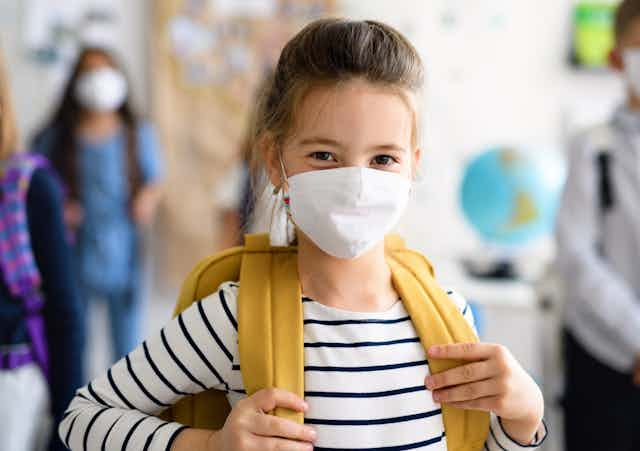When COVID-19 arrived, it quickly became clear that older age was the biggest risk factor for developing severe disease. Indeed, there are few diseases for which age is so clearly the most important risk factor.
NHS doctors have seen this daily. There have been over 131,000 UK deaths from COVID-19, but early research (still awaiting review by other scientists) suggests that very few children (fewer than 30 in the UK) have died from COVID-19 or related conditions. Consequently, children have been regarded as being at low risk.
However, as the consensus grows that the virus will become endemic, and with most high-risk people (in rich countries) now vaccinated, questions about how COVID-19 affects children have become prominent. We therefore sought to understand this – particularly in relation to the vast majority of children who do not need hospital care. Here’s what we found.
Most children recover quickly
We looked at children’s illness using data from the COVID Symptom Study, a citizen science project in which members of the public log their (or their children’s) COVID-19 symptoms and test results through an app. We assessed children who tested positive, whose test coincided with them reporting typical COVID-19 symptoms, and in whom the reporting of symptoms continued regularly for at least 28 days after their illness started.
We found that children with COVID-19 most commonly suffered from headaches, fatigue, fever and sore throat. They usually got better quickly: the median length of illness was six days – slightly shorter (five days) for primary school children and longer (seven days) for teenagers.
As many as 4.4% of children reported ongoing symptoms at or beyond 28 days (compared with 13.3% of adults, using the same methodology). This rate was slightly higher in older children (5.1%) compared with younger children (3.1%). However, nearly all children (98.4%) had recovered by eight weeks, suggesting that long-lasting illness is less common in children than in adults.
Importantly, the number of symptoms in these children with long illness didn’t appear to increase over time: on average, they had six different symptoms during their first week of illness but after day 28 had an average of just two. The most common symptoms (over their entire illness) were fatigue, headache, loss of smell and sore throat, with the first three of these most likely to be longer lasting.
We also looked at responses to direct questions posed by the COVID Symptom Study app about symptoms that might affect learning, such as “brain fog”, dizziness, confusion and low mood. Brain fog was reported in 9% of younger and 20% of older children (on average lasting two days in older and one day in younger children); and dizziness in 14% of younger and 26% of older children (lasting two days in each group). Low mood was reported in 8% of younger and 16% of older children (also lasting two days in each group).
Making comparisons
We then compared these results against those of children who had COVID-like symptoms, recorded them on the app, but ended up testing negative (and so who may have had been infected with another virus, such as rhinovirus or adenovirus). These children had, on average, shorter illness (only three days). Very few had symptoms lasting four weeks.
However, those children without COVID-19 who were ill for more than four weeks reported more ongoing symptoms than those who tested positive for COVID-19. This provides an important reminder: assessing and treating any child who is unwell should be our priority, whether in the pandemic or at other times, whether it’s COVID-19 or any other illness.
Our findings are consistent with studies from Switzerland and Australia, which also showed that most children recover fully from COVID-19. Our estimates of the number of children with longer illness duration are, however, lower than the estimates from the UK Office of National Statistics (ONS). This may be due to different ways of assessing lasting illness, but it’s hard to be sure as the ONS’s methods haven’t yet been published in full.

Like all studies, our research has some important limitations. We only captured those children who had an adult who was part of the COVID Symptom Study, was using the app and willing and able to report for a child.
We also only captured data from children whose symptoms prompted testing for COVID-19. This is both a strength (their symptoms coincided with the time they were tested) and a weakness (we didn’t capture children who were asymptomatic or with symptoms too mild to prompt testing, or who didn’t have access to testing).
Also, our study participants, while numerous, don’t fully represent the wider UK population by ethnicity and socioeconomic status. Other studies underway will be able to help address some of these limitations.
What do these findings mean?
Our results have implications for several areas of public health policy. Even a small percentage of children with COVID-19 developing long-lasting symptoms still represents a large absolute number of children. We therefore should consider what paediatric and primary-care services might be needed and the types of support children with lasting illness might need at home and at school.
A network of specialist “long COVID” advisory services for children and young people is being set up across England, bringing together expert clinical teams including paediatricians, psychiatrists, physiotherapists, psychologists, speech and language therapists, nurses and occupational therapists. One question our research raises is whether these new services should be only for children with confirmed COVID-19 or if they should extend to all children with long-lasting symptoms after illness, who otherwise might not have access to the same support.

Secondly, there’s vaccination. We hope our study contributes to understanding around how children are affected by COVID-19 and how many might suffer long-lasting symptoms – to help inform current debate around vaccination in young people.
Finally, our findings should be broadly reassuring as children return to more “normal” in-person schooling in the UK. Our data show that for most children, COVID-19 is a short-lived illness.


